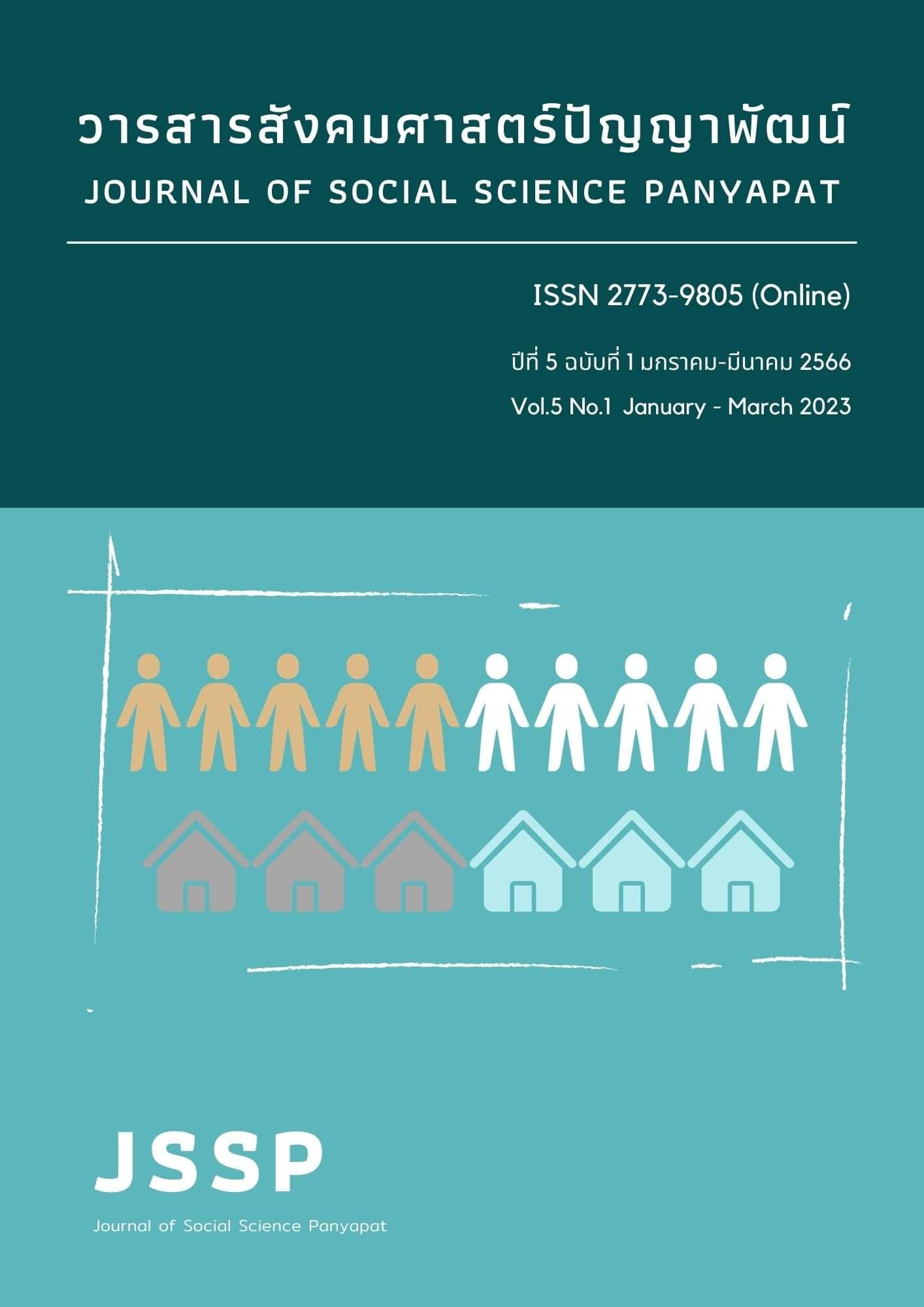ปัจจัยที่มีผลกระทบต่อดัชนีราคาเหล็กเส้นภายในประเทศไทย
คำสำคัญ:
ดัชนีราคา, เหล็กเส้น, วิธีกำลังสองน้อยที่สุดสองขั้นบทคัดย่อ
บทความวิจัยนี้มีวัตถุประสงค์เพื่อศึกษาปัจจัยทางเศรษฐกิจที่ส่งผลกระทบต่อดัชนีราคาเหล็กเส้นภายในประเทศไทย ข้อมูลที่ใช้ในการศึกษาเป็นข้อมูลรายเดือน ในช่วงปี พ.ศ. 2555 ถึง ปี 2564 รวมระยะเวลา 10 ปี จำนวน 120 ข้อมูล โดยใช้วิธีการวิเคราะห์ข้อมูลเชิงพรรณนาและการวิเคราะห์ข้อมูลเชิงปริมาณด้วยวิธีกำลังสองน้อยที่สุดสองขั้น ในการหาขนาดและทิศทางของผลกระทบจากตัวแปรอิสระต่อตัวแปรราคาเหล็กเส้นในประเทศ การศึกษานี้มีข้อจำกัดด้านการหาข้อมูลเชิงปริมาณด้านเทคโนโลยี ดังนั้นทำให้การศึกษานี้ยังไม่ได้นำปัจจัยที่มีผลกระทบอย่างมากต่อราคาเหล็กเส้นภายในประเทศไทยมาพิจารณา ข้อค้นพบสำคัญที่ได้จากการศึกษา คือ ปัจจัยที่ส่งผลกระทบต่อราคาเหล็กเส้นภายในประเทศประกอบด้วย 4 ปัจจัย ได้แก่ การเปลี่ยนแปลงของ ผลิตภัณฑ์มวลภาคก่อสร้าง ดัชนีราคาซีเมนต์ ดัชนีราคาน้ำมัน ดัชนีราคานำเข้าเหล็กเส้น ผลการศึกษา พบว่า ปัจจัยที่ส่งผลกระทบต่อดัชนีราคาเหล็กเส้นภายในประเทศไทยประกอบด้วย 4 ปัจจัย ได้แก่ โดยสามารถอธิบายตัวแปรที่ส่งผลกระทบต่อราคาเหล็กเส้นภายในประเทศที่สำคัญ 4 ประการ คือ ประการแรก ถ้า GDP เปลี่ยนไป 1,000 ล้านบาทจะทำให้ราคาเหล็กเส้นเปลี่ยนแปลงไป 0.0169 จุด กำหนดให้ปัจจัยอื่นคงที่ ประการที่สอง ถ้าดัชนีราคาซีเมนต์ เปลี่ยนแปลงไป 1 จุดจะทำให้ราคาเหล็กเส้นเปลี่ยนแปลงไป 0.0847 จุด กำหนดให้ปัจจัยอื่นคงที่ ประการที่สาม ถ้าดัชนีราคาน้ำมันเปลี่ยนแปลงไป 1 จุดจะทำให้ราคาเหล็กเส้นเปลี่ยนแปลงไป 0.0706 จุด กำหนดให้ปัจจัยอื่นคงที่ ประการที่ 4 ถ้าดัชนีราคานำเข้าเหล็กภายในประเทศเปลี่ยนแปลงไป 1 จุดจะทำให้ราคาเหล็กเส้นเปลี่ยนแปลงไป 0.9253 จุด กำหนดให้ปัจจัยอื่นคงที่ สำหรับข้อเสนอแนะของการศึกษานี้ ผู้วิจัยเห็นว่าปัจจัยที่ส่งผลกระทบต่อดัชนีราคาเหล็กเส้นภายในประเทศไทย ผลิตภัณฑ์มวลรวมภาคก่อสร้าง ดัชนีราคาซีเมนต์ ดัชนีราคาน้ำมัน และดัชนีราคานำเข้าเหล็กเส้น มีความสัมพันธ์กันกับดัชนีราคาเหล็กเส้นภายในประเทศไทยในทิศทางเดียวกัน ซึ่งทางหน่วยงานของภาครัฐควรมีนโยบายและแผนยุทธศาสตร์ของอุตสาหกรรมก่อสร้าง โดยการสร้างการวิจัยและพัฒนาเกี่ยวกับอุตสาหกรรมเหล็กให้มีประสิทธิภาพและได้ผลผลิตที่เพิ่มมากขึ้น
เอกสารอ้างอิง
กระทรวงพาณิชย์. (2564). ฐานข้อมูลดัชนีการค้า. สืบค้น 4 สิงหาคม 2565. จาก http://www.price.moc.go.th.
เกศกาญจน์ โพธิ์ปิ่น. (2558). ปัจจัยที่มีผลต่อปริมาณการนำเข้าเหล็กลวดของประเทศไทยจากสาธารณรัฐประชาชนจีน. วารสารเศรษฐศาสตร์และกลยุทธ์การจัดการ, 2(2), 29-37.
เข็มชาติ วารสินธุ์ชัย. (2558). ศึกษาปัจจัยที่ส่งผลกระทบต่อราคาเหล็กเส้นภายในประเทศไทย. (เศรษฐศาสตรมหาบัณฑิต, มหาวิทยาลัยเกษตรศาสตร์).
ชุติมา สิงหนาท. (2551). ผลกระทบของเขตการค้าเสรีไทย - ออสเตรเลียต่อการค้าระหว่างประเทศของอุตสาหกรรมนมและผลิตภัณฑ์นม. (เศรษฐศาสตรมหาบัณฑิต, มหาวิทยาลัยเกษตรศาสตร์).
ฤทธิชัย จันทร์ทอง. (2558). ศึกษาปัจจัยกำหนดอุปสงค์การนำเข้าเหล็กเพลากลมจากประเทศญี่ปุ่น. (เศรษฐศาสตรมหาบัณฑิต, มหาวิทยาธรรมศาสตร์).
สถาบันเหล็กและเหล็กกล้าแห่งประเทศไทย. (2562). รายงานสรุปสถานการณ์อุตสาหกรรมเหล็ก ปี พ.ศ. 2561. สืบค้น 1 พฤศจิกายน 2565. จาก http://www.isit.or.th.
Danso, H., & Obeng-Ahenkora, N. K. (2018). Major determinants of prices increase of building materials on Ghanaian construction market. Open Journal of Civil Engineering, 8(2), 142-154.
Kamaruddeen, A. M. (2019). Factors Influencing the Price of Selected Building Materials in Northern Malaysia: Borneo. Journal of Sciences and Technology, 2(1), 7-12.
Nguyen, P. T., & Nguyen, Q. L. H. T. T. (2020). Critical factors affecting construction price index: An integrated fuzzy logic and analytical hierarchy process. The Journal of Asian Finance, Economics and Business, 7(8), 197-204.
ดาวน์โหลด
เผยแพร่แล้ว
รูปแบบการอ้างอิง
ฉบับ
ประเภทบทความ
สัญญาอนุญาต
ลิขสิทธิ์ (c) 2023 วารสารสังคมศาสตร์ปัญญาพัฒน์

อนุญาตภายใต้เงื่อนไข Creative Commons Attribution-NonCommercial-NoDerivatives 4.0 International License.


